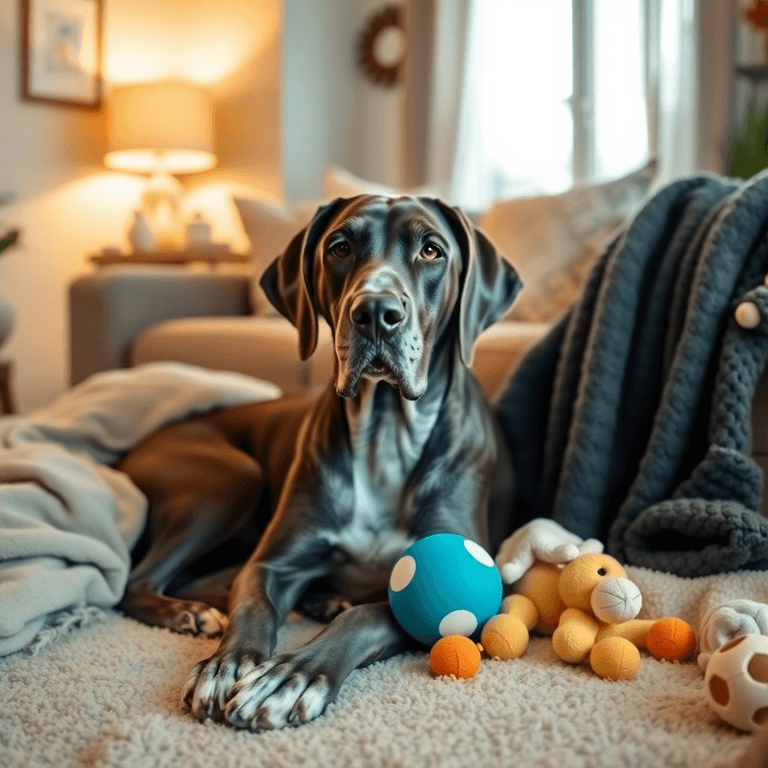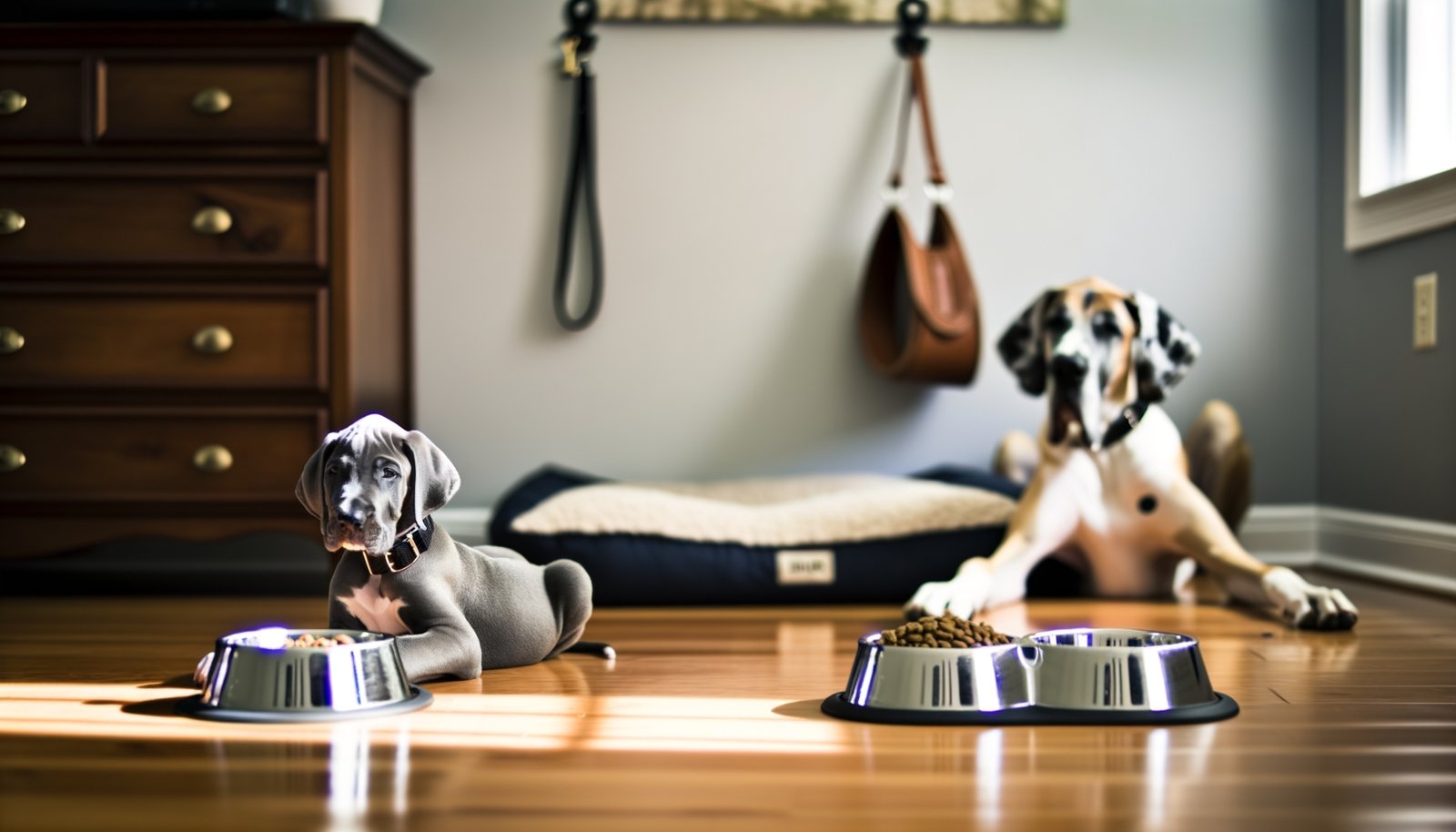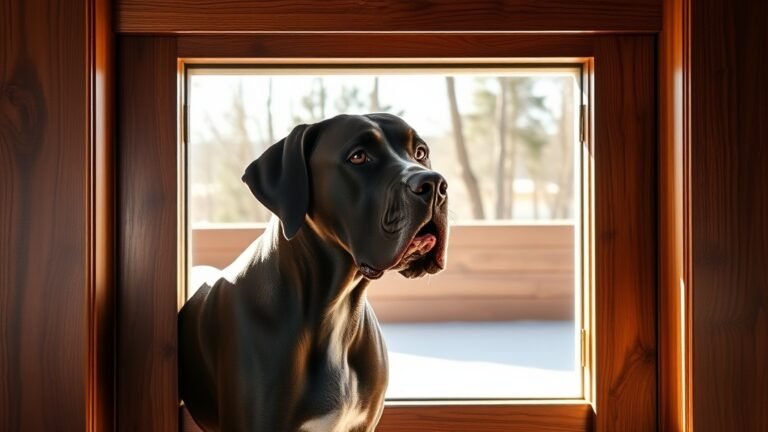How to Reduce Anxiety in a Great Dane

Reduce Anxiety in Your Great Dane
Let me tell you something – us Great Danes can get pretty nervous sometimes, and trust me, when a 150-pound dog gets anxious, everyone notices! But don’t worry, I’ve got some paw-some tips to help my fellow gentle giants chill out.
First things first – we LOVE routines! Feed me at the same time every day, and I’ll be your best friend forever (well, I already am, but you know what I mean). When my humans stick to a schedule, I know what’s coming next, and that makes my giant heart feel much calmer.
Speaking of hearts, we need our own special chill-out zone. I’m not exactly a lap dog, so make sure my bed is big enough for all of me – and trust me, there’s a lot of me! Keep it somewhere quiet where little humans and other pets won’t bug me when I need some alone time.
Here’s the thing about training – we’re smart cookies, so use treats and praise to help us learn. Start small with whatever makes us nervous. If I’m scared of the vacuum cleaner (and honestly, who isn’t?), let me see it from far away first, give me treats, then slowly get closer over time.
Don’t forget we need LOTS of exercise! A tired Great Dane is a happy Great Dane. Those puzzle toys are great too because they keep our brains busy, and trust me, a bored Great Dane can get into some pretty big trouble.
If nothing works, take us to the vet. Sometimes we feel yucky inside, and that makes us act weird on the outside.
Understanding What Triggers Anxiety in Great Danes
Hey there, humans! Let me tell you what makes us Great Danes shake in our oversized paws.
You might wonder why we big guys get nervous more than other dogs. Well, it’s complicated being a gentle giant! Our genes made us extra sensitive to scary stuff around us. When loud noises happen out of nowhere, we don’t like it one bit. New places? Forget about it – they make us worried. And don’t even get me started on when you leave us alone. We hate that!
Here’s the funny thing – we’re huge, but that makes things worse! We notice when spaces feel too small for our massive bodies. Have you ever tried squeezing into a tiny car? That’s how we feel in small rooms. It’s like being a basketball player in a dollhouse. Our keen sense of hearing makes us particularly alert to unexpected sounds, intensifying our anxiety.
We’re also super attached to our pack (that’s you, by the way). When our favorite humans disappear, even for five minutes, we think you might never come back. Our dramatic reactions probably seem silly to you, but we can’t help it. We love you too much!
The good news is that understanding what freaks us out helps you make us feel better. When you know we don’t like changes or tight spaces, you can help us stay calm and happy. We promise we’re trying our best to be brave! Identifying triggers can be a key step in managing our anxiety effectively.
Recognizing the Warning Signs and Symptoms
Hey there, humans! It’s me, your gentle giant Great Dane, and I need to tell you something important. Sometimes I get really worried and scared, and I want you to know how to spot when I’m feeling anxious.
When I’m stressed out, my body does some pretty obvious things. I started panting like I had just run a marathon (even though I was lying on the couch). I might shake like a leaf in a thunderstorm, and I drool way more than usual – sorry about your clean floors!
My behavior gets pretty weird, too. I’ll walk back and forth like I’m wearing a path in your carpet. Sometimes I chew up your favorite shoes (oops!), bark at absolutely nothing, or try to squeeze my massive self under the coffee table to hide. You know how I normally love attention? Well, when I’m anxious, I might just want to be left alone.
I also do strange things that don’t make much sense, like licking the same spot on my paw over and over or scratching when nothing’s itchy. I become super alert to every tiny sound – that squirrel outside suddenly seems very suspicious! I might crouch down low or try to make myself invisible behind the curtains, which is pretty hard when you’re my size. It’s also important to keep an eye on my behavioral changes, as they can be early indicators of underlying health issues.
Watch out for changes in my eating, sleeping, and bathroom habits too. These usually happen before I start acting really stressed, so they’re like early warning signs that something’s bothering me. It’s important to recognize signs of distress early so we can work together to help me feel better.
Creating a Calming Environment for Your Dog
Woof! So you’ve figured out that I’m feeling a bit anxious, huh? Well, let me tell you what really helps this giant pup feel better in my own home.
First things first – I LOVE having a routine! When my humans feed me at the same time every day and take me for walks on schedule, I feel so much calmer. It’s like knowing what’s coming next makes my big doggy brain relax. No more wondering “When will dinner happen?” or “Are we going outside today?” My stress levels drop way down when I can predict what’s happening. This structure is essential for building confidence and reducing anxiety in dogs like me.
And can we talk about my safe space? I need a place to go when the world feels overwhelming and scary. My humans set up this awesome quiet corner with my favorite blanket and a comfy bed that’s big enough for me (finding furniture for a Great Dane is no joke!).
When the doorbell rings or there’s thunder outside, I just waddle over to my special spot and chill out. Plus, having a dedicated safe space helps reduce my anxiety and encourages me to feel secure in my environment.
The best part is that having these routines and my cozy hideaway helps me behave better overall. I’m less likely to knock things over when I’m nervous or pace around the house like a worried giant. My humans are happy, I’m delighted, and the cat… well, she’s still plotting against me, but that’s normal!
Trust me, we Great Danes need structure and comfort zones just like everyone else – we’re just really, really big, so we need them!
Consistent Daily Routines
Woof! Let me tell you about my favorite thing – having the same awesome schedule every single day!
You humans might think routines are boring, but for us Great Danes, they’re like having a crystal ball that tells us exactly what’s coming next. And trust me, when you’re as big as I am, knowing what’s happening helps me stay cool and collected instead of being a giant nervous wreck. Proper training is essential for creating that predictability in our lives.
Here’s the deal – when my humans feed me at the same time every morning, take me for walks at regular times, and put me to bed on schedule, my brain gets super happy. It’s like my whole body relaxes because I know exactly when the good stuff is coming. No more pacing around wondering “When’s dinner?” or “Are we going for a walk?”
The best part? I don’t have to worry about scary surprises anymore. Before my humans got smart about routines, I used to jump at every little sound and follow them around like a 150-pound shadow. Now I’m way more chill because I can predict what’s happening next.
My routine also helps me control my excitement better. Instead of bouncing around like a kangaroo when I see my leash, I’ve learned to sit nicely because I know walk time is walk time. Establishing clear communication is essential for creating a calm environment, and it helps me understand what my humans expect from me.
Trust me, fellow Great Danes – ask your humans for a good routine. Your stress levels will thank you, and you’ll feel like the confident, happy giant you were meant to be!
Safe Quiet Spaces
My humans figured out something super important – I need my own special hideout! When the world gets too scary or loud, I need a place where I can chill out without anyone bothering me.
Let me tell you, finding a cozy spot isn’t easy! My humans got me this excellent big bed that actually fits my giant paws and long legs. It’s like a cloud that hugs my whole body – way better than trying to squeeze into those tiny dog beds that make me look like I’m wearing baby clothes.
The best part? My hideout is super quiet. No more jumping every time the garbage truck rumbles by or the neighbor’s Chihuahua starts his daily screaming match. My humans somehow made it so the sounds from outside can’t sneak in and mess with my zen. This is important because Great Danes can experience separation anxiety if they feel overwhelmed.
They put my safe space in the back corner where people don’t stomp around all the time. Smart move, humans! Nobody wants their relaxation time interrupted by Uncle Roy’s loud phone calls or little cousin Brenda practicing her tap dancing.
The lighting is perfect too – nice and dim like a fancy spa. Plus, it smells like all my favorite things because my humans put my special blanket there.
When I’m feeling overwhelmed, I lumber over to my sanctuary and flop down like the majestic giant I am. Before I knew it, I was back to my normal goofy self instead of being a nervous wreck! It’s crucial for me to have a calm demeanor that helps me cope with stress and anxiety.
The Power of Exercise and Mental Enrichment
Hey there, fellow humans! It’s me, your friendly neighborhood Great Dane, and boy do I’ve some thoughts about this whole anxiety thing.
So here’s the deal – when us giant pups get all worked up and anxious, we sometimes do things that make our humans not so happy. Like maybe turning that fancy couch into confetti or giving the garbage can a complete makeover. Trust me, it’s not because we’re bad dogs. We’re just bursting with energy, and our big brains need something to do!
The best cure for our jittery feelings? Getting our bodies moving and our minds working! My humans learned that taking me on long walks, playing fetch (though I might accidentally knock someone over with my enthusiasm), and letting me splash around in water helps me feel way more chill. It’s like all that nervous energy just melts away when I’m running around.
But here’s the cool part – my brain needs exercise too! Those puzzle toys that make me work for my treats? Pure genius! Sniffing games where I’ve to find hidden goodies? Sign me up! Even learning new tricks keeps my mind so busy that I forget about whatever was making me nervous in the first place.
Scientists say that when we exercise our bodies AND our brains together, we feel happier and less stressed out.
And honestly, after just a couple of weeks of this routine, even my humans noticed I was way more relaxed and less likely to redecorate their living room!
Effective Treatment Approaches and Interventions
When My Humans Need to Step Up Their Game
Woof! So you’ve tried the whole “let’s go for walks” thing and moved my food bowl around, but I’m still shaking like a chihuahua during thunderstorms? Time for the big guns, my human friends!
Listen, I know I’m huge, but sometimes my brain gets all scrambled like Sunday morning eggs. That’s when you need to bring out the fancy training stuff.
There’s this cool thing called desensitization – basically, you help me get used to scary things little by little. Like, don’t throw me into a room full of vacuum cleaners right away. Start with showing me one from across the yard, then maybe closer, until I realize it’s not actually a monster trying to eat the carpet.
Then there’s counterconditioning, which is a fancy way of saying “teach me that scary stuff actually means good stuff.” When I hear thunder, give me treats! When the doorbell rings, break out the bacon! My brain will start thinking, “Hey, maybe loud noises mean dinner time!”
Sometimes, though, even we gentle giants need a little extra help. That’s where the medicine cabinet comes in. Don’t worry – I’m not talking about anything weird. Just some calming stuff that helps my brain chill out while we work on the training.
Some dogs get pills, others get natural supplements that taste like treats. Either way, it’s like having a chill pill for my Great Dane-sized worries!
Behavioral Training Methods
How My Humans Helped Me Stop Being Such a Scaredy Dog
So there I was, all 150 pounds of me, hiding behind the couch because someone rang the doorbell. Pretty embarrassing for a dog my size, right? Lucky for me, my humans figured out some pretty clever ways to help me chill out.
The fancy term they use is “systematic desensitization,” but I call it “baby steps training.” My humans started by playing doorbell sounds really quietly while I munched on my favorite treats. At first, I could barely hear it, but slowly they made it louder. Before I knew it, I wasn’t jumping out of my fur every time someone visited!
They made a whole list of scary things, starting with the easy stuff and working up to the really terrifying things like vacuum cleaners.
The best part? I got rewarded for being brave! Every time I stayed calm instead of turning into a giant chicken, I got treats, belly rubs, or my favorite squeaky toy. My humans called this “positive reinforcement,” but I called it “awesome.” They were really smart about timing, too – the second I did something good, BAM, reward time!
The coolest trick was something called “counterconditioning.” Instead of teaching me to be scared, they taught my brain to be happy and relaxed when scary things happened. Now, when I hear thunder, I actually get excited because I know treat time is coming!
My humans also made sure I met lots of different people, dogs, and situations when I was a puppy. This helped me learn that most things aren’t actually trying to eat me. Who knew?
The training worked because my humans were super consistent. Every single day, we practiced the same stuff until my brain finally got the message. Now I’m way more confident, and I only hide behind the couch when there are really good crumbs back there!
Medical Treatment Options
When My Big Paws Need Extra Help: Medicine That Makes Me Feel Better
Woof! Sometimes even us Great Danes need a little extra help when we’re feeling scared or worried. When my humans have tried teaching me to be brave but I’m still shaking like a leaf during thunderstorms, that’s when they call the special dog doctor – the veterinary behaviorist!
These intelligent humans know all about doggy brains and can give me medicine that works together with my training. It’s like having a superhero team fighting my anxiety!
| Type of Medicine | What They’re Called |
|---|---|
| Happy Pills (SSRIs) | Fluoxetine, Sertraline |
| Quick Calm-Down Medicine | Alprazolam, Lorazepam |
| Special Calming Drops | Sileo (dexmedetomidine) |
| Natural Helpers | L-theanine, Melatonin |
Here’s what I’ve learned from other Great Danes: medicine plus training equals one much happier giant dog! When I’m having a really bad day (like when those scary fireworks go off), the quick-acting medicine helps me chill out fast. But for everyday worries, the longer-lasting medicine keeps my tail wagging instead of tucked between my legs.
The best part? My vet keeps checking on me to make sure everything’s working just right. They watch how I’m doing and change my medicine if needed. It’s like having a personal trainer, but for my feelings! Pretty cool for a dog whose head reaches the kitchen counter, right?
Genetic Factors and Health-Related Considerations
Hey there, fellow humans! It’s me, your friendly neighborhood Great Dane, and I need to tell you something important about us gentle giants.
So here’s the scoop – we Great Danes are pretty awesome dogs, but sometimes our genes make us a bit more worried than other pups. Think of it like this: if your mom gets nervous about thunderstorms, you might too! It’s the same with us dogs. Our parents pass down things like how our brains handle scary stuff.
Just like humans inherit traits from their parents, we Great Danes can inherit anxiety tendencies through our genes too!
Here’s what’s really cool though – you humans can actually check our health early on to see if we might’ve problems that make us extra anxious. Sometimes our big hearts don’t work perfectly, or our thyroid glands (those are like tiny engines in our necks) get wonky.
Even our brains can have hiccups! When these things aren’t working right, we get stressed out more easily.
Intelligent humans can even do special tests on our DNA – that’s like our doggy blueprint – to see if we’re likely to be nervous Nellies. They can also look at our mom and dad’s personalities because, let’s face it, if your parents were scaredy-cats, you might be too!
The best part? Once you know all this stuff about us, you can help us feel better with special training and activities that work just for our big, goofy personalities. Pretty neat, right?
Final Thoughts
Woof! It’s me, your friendly neighborhood Great Dane, Yeti, and I need to tell you something important – us big dogs get scared too! I know, I know, you probably look at my giant paws and think I’m fearless, but trust me, that vacuum cleaner still makes me run for the hills.
Here’s the thing about us Great Danes: we might be huge on the outside, but we’re oversized teddy bears on the inside. We worry about stuff just like you do. Maybe it’s thunderstorms, maybe it’s being left alone, or maybe it’s that weird noise the washing machine makes. Whatever it is, we need help dealing with our worries.
The good news? There are lots of ways to help us chill out! First, you can make our space feel safer. Think cozy blankets, quiet corners, and maybe some calming music. We also love having a routine – walks at the same time, meals on schedule, that sort of thing. It makes us feel secure when we know what’s coming next.
Exercise is huge for us (pun intended). A tired Great Dane is usually a happy Great Dane. Take us for walks, play fetch, or let us run around the yard. When we burn off energy, we’re less likely to stress about every little thing.
Sometimes we need extra help learning how to be brave. That’s where training comes in. You can teach us that scary things aren’t actually dangerous. Start small and be patient with us – we’re trying our best!
Remember, we Great Danes are sensitive souls in giant bodies. With the right care, we can overcome our worries and be the confident, goofy companions you love.
References
- https://greatdanecare.com/treating-great-dane-anxiety-problems/
- https://www.petmd.com/dog/conditions/behavioral/c_dg_fears_phobia_anxiety
- https://iheartdogs.com/7-sure-fire-ways-to-calm-your-great-danes-anxiety/
- https://grdane.com/signs-your-great-dane-is-upset/
- https://www.helsinki.fi/en/news/life-sciences/fearful-great-danes-provide-new-insights-genetic-causes-fear







6 Comments